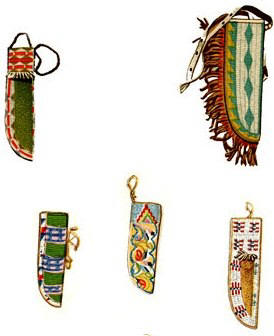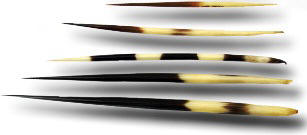Knife Sheaths
Many knife sheaths were elaborately decorated by intricate quillwork and beadwork. The knife sheaths might also be painted and adorned with feathers or brass studs. The designs on knife sheaths included traditional Native American designs used by specific tribes or symbolic designs, for more information refer to Native American Symbols, the designs on knife sheaths might also be personalized to the wearer or reflect the symbols associated with his clan.
 | 
|
| Beaded Sheaths | Quill Sheath |
Making Knife Sheaths - Materials used to make the Knife Sheaths
Knife sheaths were made by using a combination of raw materials but the basic sheath was made from hides or leather. Tanned hides, rawhide or buckskin was the most common types of leather used to make sheaths for knives.
- Tanned hides: Tanning is the process of treating skins of animals to produce leather. The animal skin was softened by soaking in water. The hide or skin would then be pounded to remove any remaining flesh and fat and scraping any hair fibers off the hide. The process would then continue by soaking the skin in a solution of animal brains or urine
- Buckskin or Deerskin: A soft yellowish suede tanned leather originally from deerskin i.e. the skin of a male deer, a buck
- Rawhide: Rawhide is not leather, but a de-haired hide that is not tanned. Most rawhide comes from cows, but it can come from any animal, such as elk or deer. Rawhide is tough and durable
The hide or leather material was then often decorated with quillwork or beadwork. An additional embellishment was to add a fringe to the knife sheaths.
Making Knife Sheaths - Quillwork
Sheaths for knives were decorated by a technique called quillwork. The quills refer to porcupine quills. Porcupine quilling is an ancient Native American Indian art used particularly among Great Plains Indians and Woodland Indians. The method for creating quillwork involved softening and dying stiff porcupine quills and weaving them on to the leather knife sheaths.
| | |
 |  |
| Porcupine Quills | Porcupine |
Making Knife Sheaths - Beadwork
Knife sheaths were also decorated by some tribes by a technique called beadwork. Native American beads were carved from natural materials like shells, coral, turquoise, wood, amber, animal bones, horns and teeth and used to produce beaded leather for making knife sheaths. The beads were sewn onto the leather individually, or in loops, or rows, of beads previously stitched together into strings using animal sinew.
Knife Sheaths and Shapes of Knife Blades
Making a Knife Sheaths was a time consuming task. Native American Knife Sheaths were made in many different styles for protecting different types and sizes of blades types of blades. The following chart shows the different shapes of knife blades that were protected by knife sheaths
Shapes of Native American Knife Blades
for Knife Sheaths |
| | Shapes of Blades |
| Description of Native American Blades
| |
| |  |
| The normal blade | |
| |  | | The curved blade | |
| |  | | The large drop-point blade | |
| |  |
| The spear point blade has a central spine and is double-edged like a large dagger or a spear head. Refer to Spears
| |
| |  | | The dagger
| |
| | Types of Native American Knife Blades | |
Knife Sheaths
- Description and definition of Knife Sheaths
- Materials required to make Sheaths
- Making a Knife Sheaths - method of construction
- The use of the Sheath
- Interesting facts and information about Native American knife sheaths for kids and schools
Knife Sheaths - Pictures and Videos of Native Americans
Native American Weapons - sheaths. Discover the interesting facts and information which relate to the History of Native Americans and the weapons they used such as the Knife Sheaths. The pictures on this site show the weapons and tools that were used by various Native Indian tribes that can be used as a really useful educational history resource for kids and children of all ages. We have included pictures and videos to accompany the main topic of this section - Knife Sheaths. The videos enable fast access to the images, paintings and pictures together with information and many historical facts. All of the articles and pages can be accessed via the Native Indian Tribes Index - a great educational resource for kids providing an unusual insight into their culture. We hope you enjoy watching the videos - just click and play - a great resource for gaining facts and information about the life of Native American Indians.